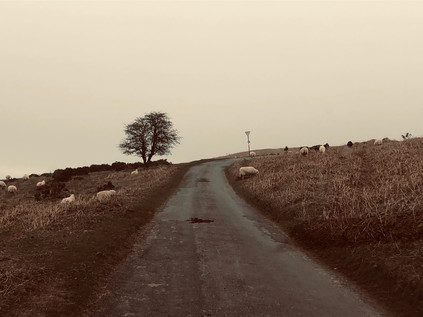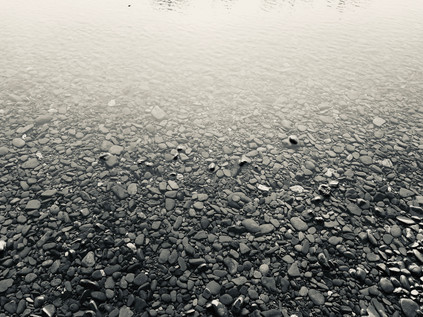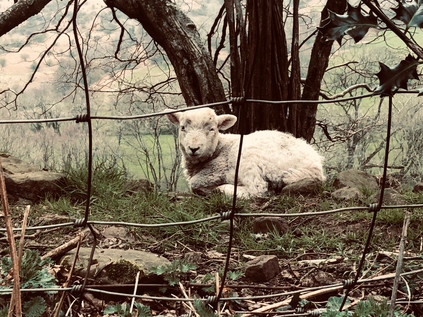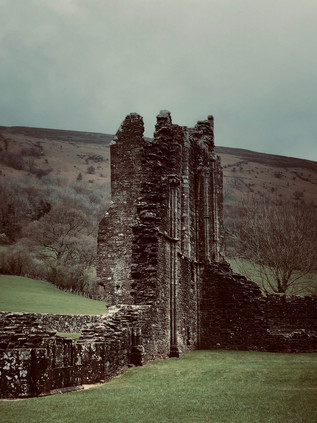
A Solid Mass of Heaven: A Weekend in The Borderlands
Posted in Travel on Sunday 31st March 2019 at 9:03pm
The drive into Wales was fractious and slow. The motorway was mired in congestion and overwhelmed with traffic, so we slalomed across the map heading steadily westwards on a successively narrower corridor of minor roads, a routing which made me - the navigator - distinctly unpopular for a while. Skirting major towns and curving along wooded channels, there wasn't much of a view beyond the monotony of a white line and the the threat of oncoming traffic. Finally, the valley opened before us: Hay Bluff glowered over the scene from the south, while our road briefly skirted the little town of Hay-on-Wye before heading into the countryside again. By a series of lucky turns and informed guesses we made our way to Glasbury-on-Wye and The Grange - the quiet bolthole we'd found for the weekend. It was good to get away - life had felt pressured and a little off-kilter these past few weeks. We were adjusting to new routines and new challenges, while integrating the same old pressures and stresses into a world where we both worked for the same employer. Escape felt well-earned and rare, and the fine old farm house with its casually friendly hostess and loping guardian hounds who were far too friendly to truly defend the place. We were instantly comfortable here, and celebrated by escaping to the local hostelry for too much food and wine. It was good to be in the Borderlands.
But this trip was also about exploring, and I was out early the next morning to make the walk beyond the pub and into the tiny hamlet of Glasbury. At the meeting of roads near the gateway to the common, I found a familiar sign: 'London Borough of Redbridge'. Oddly out of place here, the distinctive emblem and bold, plain design struck me first. I was transported to distant walks, connected strangely back to my wandering in the capital. Since 1963, the borough had sent groups of students - sometimes up to 1800 each year - to Glasbury to experience the outdoors and particularly the opportunity to canoe on the Wye. The future of the centre was first threatened in 2011 when subsidies fell, and it finally closed its doors in 2015 with the Borough seeking a £1 million receipt for the property against a challenging savings target. The building stands, decaying and apparently unsold while the signs still show the anomalous ownership. Instead of the fast-running Wye, the young people of Redbridge will be encouraged to enjoy the comparatively local Fairlop Waters instead. Having walked their edges recently, I can testify to the impressive sweep of the park and the windy lakes certainly looked well-used by boaters. But were they a substitute for the adventure of a journey out here? It was sad to think of this decades-old trip to the mysterious valleys no longer taking place.

The Wye is broad and shallow at Glasbury, and I crossed the gravelled strand which led to its banks under the shadow of the road bridge. The river had scoured deep holes near the piers of the bridge which formed deep, dangerous pools requiring care in navigating a route under the carriageway. North of the bridge the river curved gently eastwards towards Hay, dividing into multiple streams and rejoining, and later we would set out in the same direction. My last visit to Hay was lost in a haze of confused sixth-form memories. We were brought here to experience the 'town of books' and to delight in the ramshackle cottage industry which presented its charming face in the old town. I didn't quite appreciate the rather ragged, hand-to-mouth existence of bookdealers then. Even these comparatively well-to-do country types existed in a world of unlikely fellowship and bitter competition. We'd get to see that a little on our excursion: enquiries after Beat Poetry in the wrong store incurred wrathful spitting of another bookseller's name. Try him. He likes that sort of stuff. We'd duly shuffle on, each with only a few pounds to spend on wretchedly ill-used paperbacks, hustled away from the glass-fronted cases containing the really good stuff. Don't even look. That's not for you. We scaled precarious spiral stairs to look an unsorted stacks of remaindered novels, and clattered into dank basements full of songbooks and sheet-music. It was both wonderfully educating and deeply depressing. I've struggled with second-hand shops ever since. Not until a visit to Powells in Portland years later would I even dare to seek out authors I cared to find works by, always feeling so utterly deflated by the sheer volume of pulped print around me. This trip was also one of the few times I got into any real trouble at school... On a brief stop in Cheltenham on route to Hay I'd strayed into Our Price records, and came away with a 12" single of 'Fishes Eyes' by New Fast Automatic Daffodils using virtually all of my spare cash. Later, we were ushered by our English teacher into a queue under a damp marquee, each of us duly bound to line up, purchase a book of poems and have it signed by D. J. Enright. Enright was virtually unknown to me then, aside from being the editorial credit on a number of anthologies. From what I'd seen of his work he didn't belong in my naïve, resolutely teenage canon. We shuffled forward, the better-prepared clutching their Collected Poems while the more thrifty held slimmer volumes. The author, heavy browed and bowed with age and likely boredom, smiled generously and signed almost unintelligibly. I assumed poets must all have terrible handwriting. I realised at some point in this slow procession towards Enright that I had neither book nor the funds to purchase one. I clutched the signature red 'Our Price' bag conspicuously, wondering how to play this? Despite my haughty assumptions, Enright was truly an impressive figure: I didn't know of his long sojourn overseas and the near international incident he'd caused in Singapore, I didn't know of his loose but important association with 'The Movement' and that last gasp of an older school of serious British writing. All I knew was that my literary pretensions lay elsewhere, and that my wallet was empty. I shuffled in front of the author in my turn. He smiled benignly as I offered him the New Fast Automatic Daffodils record. He examined it with a wry chuckle and said he'd not expected to see this. Eventually he took us his pen, scribbled something on the cover and handed it back with a gruff laugh before turning to the next in line. As I wandered away to inspect the record, I felt the eyes of my disgusted English teacher following me across the marquee. The inscription read:
I take no responsibility for the contentsD J Enright
I was suspended for three days as I recall.
Our day in Hay-on-Wye was very different: we found great coffee in the Old Electric Shop which combined café and retro furniture sales, strolled around the busy town and explored both a shop devoted to selling maps and the wool and food stalls in the restored Butter Market. The sun blazed over the town, and I decided that rather than return in the car I'd walk back to Glasbury along the river as far as I could. We parted at the top of town near the currently under re-construction flanks of Hay Castle, and I slipped into a store to buy a little vintage brooch which Natalie had admired earlier. before setting off for the river. Access to the river was down steep steps which turned back under the road bridge and onto the path of the former Hereford, Hay & Brecon Railway. The line had closed in 1962, leaving Hay at least twenty miles from a railway connection. Taken over by the Midland Railway, the route was joined a little to the north of the station by the Golden Valley Railway, heading east from Abergavenny and Pontrilas. The railway now was a broad, well-surfaced path running alongside a steep bank down to the River. It was quiet and cool here, just occasional walkers to distract me from my mission. The town was above me but could be miles away for all its intrusion into this calm, green cutting. In fact, I was passing out of town without realising - crossing the little Login Brook which trickled by the church of St. Mary the Virgin before reaching a tumbling confluence into the river below. Here I faced a choice: press on along the old trackbed, or head onto The Warren. I wanted to stick to the river, so I took the latter route, taking a broad sweep long the river bank where it curved around private meadows criss-crossed with unofficial paths. My presence, along with that of other groups of walkers and bathers was suffered if not sanctioned, and I followed the bank as far as I could, passing a busy weir where the already broad waters of the Wye scurried over stones. Eventually I was forced to head inland, and I soon realised there was little hope of getting back to river or railway. Instead I trudged alongside the busy road to Brecon, occasionally needing to edge along the dusty carriageway when the margins of the lane were impassible. It was challenging walking, and not what I'd hoped for, but the views were incredible - as was the chance to gaze down into the clear, angry waters of the Dulas Brook and Nant Ysgallen as I passed over bridges which I'd entirely missed when we travelled over them by car. As I neared Glasbury, I ascended a steep set of wooden steps onto the railway alignment, which cut into the lower foothills above me. The last mile or so of my walk should have been through a cool, wooded nature reserve - but a farmer, tired of walkers using it as a through route, had closed the end. I was forced to retrace my steps and to edge along the road yet again. I delivered the brooch proudly, a little dustier and more tired than I'd planned to be, but glad of the walk. We headed back into Hay later, to eat in a curious and rather secretive little restaurant and to drink a little more wine than I'd usually venture. I felt I'd earned the refreshment.

On our last morning, over an excellent breakfast, our host asked if we were going to travel home via the Gospel Pass. I knew we were close to Capel-y-Ffin and Llanthony, but hadn't hazarded a mention as I figured the drive would be very challenging on more, even narrower roads. These long-contested borderlands had featured in the confoundingly complex, dreamlike novel Landor's Tower by Iain Sinclair - and while I'd seen this as a minor distraction from his London writing at the time I first devoured it, I'd been haunted by the unseen landscapes and occult associations ever since. Surprisingly, the suggestion was eagerly accepted and after taking leave of the friendly dogs and the beautiful room we were soon heading off towards Llanigon, climbing slowly on a single track road. We saw very few other vehicles, a mist descending as we climbed towards the pass where England met Wales. The driving was exhilarating at times, the road hugging the edges of long drops into the valley below - and as we climbed we realised we we driving into a cross-country cycle race and needed to pause occasionally to let each cluster of cyclists pass unhindered. The road climbed towards the ridge and opened into a square of gravel which served as a carpark. We were surrounded by sheep, their eerie cries muffled in the foggy air. Lambs tottered along behind their mother, while groups clustered along troughs of feed. For a while it was just us and the sheep up here. The pass: Bwlch yr Efengyl, may derive its English name from one of two christian myths: that Caradog brought St. Paul through the mountains here to preach the faith to the heathen Celts, or that Crusaders passed by in the 12th Century preaching and raising funds for their expedition to the Holy Land. In either case, it has an ancient feel. The earth seemed to settle slowly when stepped on, the fog to part unwillingly to let us pass through. The sheep were unaffected, able to scamper and gambol along the mountainside at will. Humans though, were less welcome now. We pressed on, down the valley to pass the tiny church of Capel-y-Ffin - the Church of the Boundary - and to descend to the ruined priory at Llanthony. There had reputedly been a place of worship here since Dewi Sant established a cell in the 6th century. The first priory was established in 1108 via the finances of the de Lacy family and had become an important Augustinian house by the 12th century. However the priory faltered as attention turned to power struggles in the monarchy at the time of King Stephen, and the 4th Prior, William Wycombe took flight to Gloucester where he established Llanthony Secunda in the comparative safety of England. The de Lacy family once again took back the land and built the vast church which can be seen in part today, surviving despite the lawlessness and rebellion which stalked the borderlands and the rebellion of Owain Glyndŵr which threatened the Abbey's income and existence.

Llanthony continued to attract new groups of the idealistic and faithful, often with unlikely leaders. First came the troubled and hot-headed Bath born poet Walter Savage Landor, intent on improving the monastery but quickly falling into dispute with the locals who stole from him and failed to undertake the works he specified. His tendency to attack opponents in libellous verse saw him fall into further expensive and interminable conflict, and he finally left Llanthony for Jersey in 1814 at speed, reputedly having been flung from a first floor window by an unhappy local. Landor was followed by Joseph Leycester Lyne who arrived in 1869 making repeated attempts to buy the Abbey ruins from the Landors to prevent the operation of a public house in the grounds and to restore a religious order, based on his own strange take on Christianity. He finally admitted defeat and purchased 32 acres of land nearby to build a new monastery. Styling himself Father Ignatius, he established Llanthony Tertia where his eccentric collision of High Anglicanism and Celtic mysticism would ultimately fail to flourish. Diarist, clergyman and nudist Francis Kilvert observed that the guileless abbot was 'robbed blind' by tradesman he paid without a contract to finish the monastery, and Lyne fell foul of the Church authorities after publicising ghostly presences and visitations by the Virgin and reportedly being ordained as a Druid. It's perhaps easy to understand why Lyne would find this spot imbued with ancient power: the veil of modern life felt as transient as the mist here, and the idea that the old and new were entwined was strong. The Honddu valley slumbered unquiet under the dew and it was possible to imagine Lyne striding out, the hem of his robe damp, to meet figures which disappeared before he could speak with them. Nor was Lyne the last to attempt an understanding of this landscape, with sculptor and typographer Eric Gill setting up a somewhat notorious artistic community in Ignatius' unfinished monastery buildings. Gill's acolytes included the painter and modernist poet David Jones who drew on mythology and mysticism in his work, much to the cost of his reputation in the future when such things fell out of mode. Gill's reputation too has suffered from revelations about his personal life and proclivities - and there is a queasy realisation that his establishment of a commune at Capel-y-Ffin may have been as much about being away from the gaze of authority and polite society as any great artistic purpose. In both cases though, these men drew on the strange power of the little Honddu valley in their work. Gill left the valley in 1928, four years after arriving, reportedly troubled by its atmosphere, inaccessibility and great distance from London where many of his clients were located.

After exploring the ruins, we ventured into the tiny bar which still operates in the undercroft of the Prior's quarters. We were welcomed by a bluff and friendly man who spoke with the assuredness of a local, despite sporting a broad Mancunian accent. Delighting in the chance to tick Washington off the list of states he'd served visitors from, he talked a great deal about his association with the area and his return each spring to operate the pub over the busier summer months. He also talked about the range of celebrity visitors, including Jimmy Page who had called in while passing through the Ewyas Valley on route to recording commitments. The well-stocked little bar-room was accessed by precarious steps, and soon all attention focused on getting an elderly local safely to a seat nearby. We purchased a copy of the undated pamphlet by L D Fancourt which provided a brief history of Llanthony, skirting some of the more lascivious details of later occupants, and slipped away back to the car, to complete our journey. The road levelled, crossing and recrossing the busy Honddu as it rushed to join the River Monnow and eventually the Wye as it snaked towards the Severn. The arms of the valley slipped back, opening into a broad undulating plain surrounding The Skirrid or Ysgyryd Fawr, the shivering mountain which still experienced minor landslides but which was said to have partially collapsed in a lightning storm at the moment of Christ's crucifixion. Beneath it, the Skirrid Mountain Inn still did business - reputedly haunted by those hung at a local assizes which held session and dispensed justice here in an early sort of one-stop-shop arrangement, or by slain rebels from the time of Glyndŵr. Myth and mystery were never far from the surface here on the border, painted and written over and over: Jones, Gill, Eric Ravilious, John Piper and even Allen Ginsberg had passed through. With this surprising revelation my circle closed with an unexpected jolt, and I was the temperamental youth looking for Beat Poetry in the musty stacks of Hay bookshops once again.
As we climbed the silvery ramp of the Second Severn Crossing, I felt the unexpected weight of history slipping away from us. It had been wonderful to be back in Wales after a long absence thanks to its association with unwelcome appointments at the Home Office Immigration & Visa Centre. Now we could rewrite our own Welsh story, in a similar way to those who'd occupied the venerable and desolate valley through which we'd passed. It felt a little like our own pilgrim's road, and I was surprised how strongly I felt the curious pressure of time and place in the Borderlands. I scolded myself a little for letting my rationalism slip for a moment, but suspected that it was the natural rather than the supernatural which truly held sway in Ewyas. It had been a fine weekend and we'd found a special place to which we wanted to return. But the journey home had been surprising and enlightening. The valley still had more secrets to share.
You can find more pictures from the trip here. This post takes its title in part from Allen Ginsberg's poem 'Wales Visitation', you can watch him reading part of it to an unconvinced William F. Buckley Jr. below...
Lost::MikeGTN
I've had a home on the web for more years than I care to remember, and a few kind souls persuade me it's worth persisting with keeping it updated. This current incarnation of the site is centred around the blog posts which began back in 1999 as 'the daylog' and continued through my travels and tribulations during the following years.
I don't get out and about nearly as much these days, but I do try to record significant events and trips for posterity. You may also have arrived here by following the trail to my former music blog Songs Heard On Fast Trains. That content is preserved here too.

